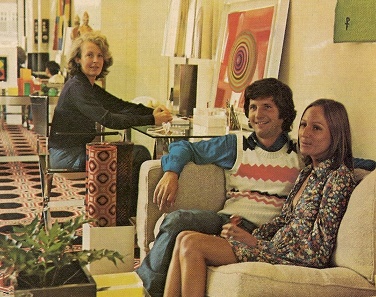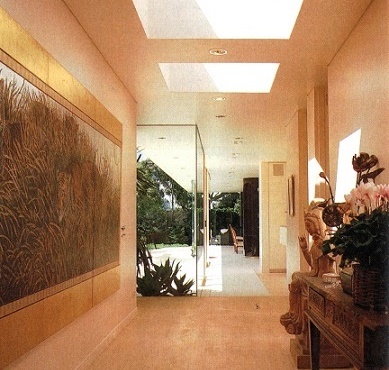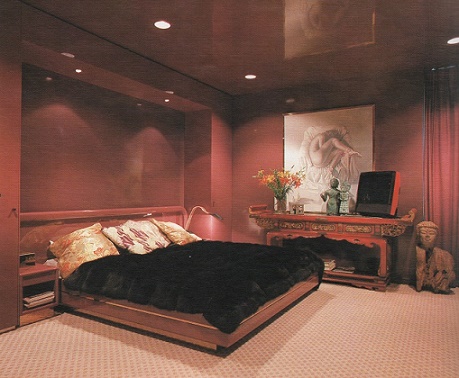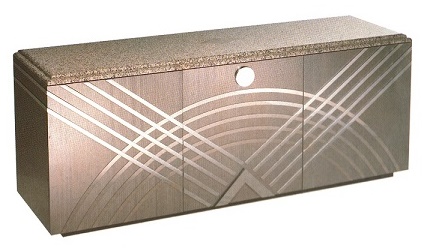Born in Budapest on 4 November 1941, Tibor Stefan Hubay was a great-grandson of the eminent Hungarian violinist Jenő Hubay (1858-1937).
Creative endeavour certainly ran in the family. Tibor's father
Jeno (Eugene) Hubay (1912-2004) qualified as an architect and engineer,
his mother Anna-Barbara (1918-2010) dabbled in fashion design,
and elder brother Gabor (1938-) became an architect, builder and
developer.
The Hubays fled their toubled homeland following the
Communist takeover in 1949 and eventually boarded a ship to Australia,
arriving
in Melbourne in 1952. With Eugene's professional qualifications
not recognised locally, he was unable to practice as an architect and,
for a time, the
family was supported by Barbara, who found work as a knitwear designer.
Completing his secondary education at St Kevin's College and Xavier College, Hubay enrolled in the Diploma of Commercial Art at RMIT and, upon graduation, was awarded the coveted Robert Menzies Prize. Leaving for overseas experience, Hubay arrived in London in 1962. After several successful years working for a leading advertising agency, he gained a position in the new design firm founded by photographer and writer Baron Alessandro Albrizzi (1935-1994). Albrizzi went on to open a chain of high-end retail design outlets in London, New York and elsewhere, and offered Hubay the rare opportunity to front a branch in Melbourne. The young designer declined, opting instead to travel to the United States to further his professional experience.
Retuning to Australia in 1969, Hubay took up a position as Creative Director at the international advertising agency McCann Erickson, which had maintained an outpost in Australia since 1959. In 1971, he represented Australia at the Biennial Exhibition of Design in Chicago and, the following year, established his own design practice in South Yarra under the name Palazzo. Also involved in the venture was Hubay's wife Christine, a French-born designer whom he had met while both were working for Albrizzi in London, and Quentin Madden (1938-2005), a well-known Toorak socialite. Of the burgeoning practice, Hubay later reflected, "It was about creating a unique look for furniture, fabric, carpet and co-ordinated products. It was international but contemporary, with steel, glass and lacquered furniture and we created a total environment." Although initially characterised by stark minimalist modernism, the Palazzo style changed over time and ultimately became synonymous with luxurious finishes such as marble, granite, anodized metal and gold leaf, providing a sumtuous backdrop to bespoke furniture, fabrics, light fittings and accessories, invariably designed and made by the company itself.
During Palazzo's early years, Hubay was involved in a television advertising campaign for Uncle Sam deodorant, in which actor Piero van Arnim, attired in a lurid red, white and blue costume, cavorted, sang and played piano in various public locations. The advertisment became wildly popular with the public and won the Gold Logie for Best Australian Commercial in 1975; decades later, Hubay still included this accolade amongst his list of awards and achievements.
Re-badged in 1984 as the Tibor Hubay Design Group, the practice fostered an enviable reputation for "commercial and domestic interiors in exclusive parts of Melbourne". Towards the end of the decade, its reputation rose at Hubay completed several prominent commercial fitouts such as the Warehouse Nightclub (1988) and the Chinois Restuarant (1989), both in South Yarra. The latter won an award for Best Restaurant Design and received coverage in the national architectural press. During this period, Hubay himself made several forays into architectural design that included two houses for himself: a beachfront weekender at Sorrento (1987) and a town residence in Toorak (1989).
Already much sought-after by discriminating residential and corporate clients, Hubay's practice received a major boost in the mid-1990s after he was engaged to work on the fitout of the Jam Factory in South Yarra, a former industrial premises converted into a cinema complex and retail centre. His deliberately kitsch Hollywood-style interiors attracted much attention, inspiring the Village Roadshow Corporation to adopt it as their new corporate identity. Formally engaged as the chain's Director of Design, Hubay was retained to refurbish other cinemas across the country and beyond. Notable amongst these projects were the Village Casino fitout at the Crown Casino complex (1997), which offered 24-hour screenings, four luxurious 'Gold Class' cinemas and a foyer with life-size statues of film characters and classic Hollywood actors, and the Art Deco-inspired refurbishment of the iconic pre-war Rivoli Cinema in Camberwell (1999). After Village Roadshow co-founded an south-east Asian offshoot in the mid-1990s, known as Entertain Golden Village, Hubay undertook further cinema fitout projects in Singapore, Bangkok and Kuala Lumpur.
In addition to his enviable reputation as an interior, industrial, furniture and lighting designer, Hubay was noted as a painter, sculptor, photographer and writer. He exhibited artwork regularly, including an early show at the Bonython Gallery (1972) and his "Post-Executive De-Sculpt" exhibition at the Irving Galleries (1991), both in Sydney. In 1989, Hubay published the Australian Interior Design Manual, which was the first comphrehensive survey of local interior design and remained a standard text for many years.
Tibor Hubay remained professionally active until his death on 2 January 2005, aged 63. Over the preceding few years, he had remained in demand for high-end residential commissions, including luxury inner-suburban apartment blocks designed by such architects as Nonda Katsilidis, Bruce Henderson and David Edelman. One typical project, for a four-storey block in South Yarra, was textbook Hubay, with an entry foyer that included bespoke brass doors, coffered ceilings and an inlaid floor of marble and granite. Hubay's final years in practice also saw him design an addition to his own house in South Yarra, and refurbish an apartment that he owned in Robin Boyd's Domain Park Towers. One of his last (and largest) commissions was the interior design of the $450 million highrise Skyline Tower apartment complex in Surfers Paradise, completed in 2003.
Completing his secondary education at St Kevin's College and Xavier College, Hubay enrolled in the Diploma of Commercial Art at RMIT and, upon graduation, was awarded the coveted Robert Menzies Prize. Leaving for overseas experience, Hubay arrived in London in 1962. After several successful years working for a leading advertising agency, he gained a position in the new design firm founded by photographer and writer Baron Alessandro Albrizzi (1935-1994). Albrizzi went on to open a chain of high-end retail design outlets in London, New York and elsewhere, and offered Hubay the rare opportunity to front a branch in Melbourne. The young designer declined, opting instead to travel to the United States to further his professional experience.
Retuning to Australia in 1969, Hubay took up a position as Creative Director at the international advertising agency McCann Erickson, which had maintained an outpost in Australia since 1959. In 1971, he represented Australia at the Biennial Exhibition of Design in Chicago and, the following year, established his own design practice in South Yarra under the name Palazzo. Also involved in the venture was Hubay's wife Christine, a French-born designer whom he had met while both were working for Albrizzi in London, and Quentin Madden (1938-2005), a well-known Toorak socialite. Of the burgeoning practice, Hubay later reflected, "It was about creating a unique look for furniture, fabric, carpet and co-ordinated products. It was international but contemporary, with steel, glass and lacquered furniture and we created a total environment." Although initially characterised by stark minimalist modernism, the Palazzo style changed over time and ultimately became synonymous with luxurious finishes such as marble, granite, anodized metal and gold leaf, providing a sumtuous backdrop to bespoke furniture, fabrics, light fittings and accessories, invariably designed and made by the company itself.
During Palazzo's early years, Hubay was involved in a television advertising campaign for Uncle Sam deodorant, in which actor Piero van Arnim, attired in a lurid red, white and blue costume, cavorted, sang and played piano in various public locations. The advertisment became wildly popular with the public and won the Gold Logie for Best Australian Commercial in 1975; decades later, Hubay still included this accolade amongst his list of awards and achievements.
Re-badged in 1984 as the Tibor Hubay Design Group, the practice fostered an enviable reputation for "commercial and domestic interiors in exclusive parts of Melbourne". Towards the end of the decade, its reputation rose at Hubay completed several prominent commercial fitouts such as the Warehouse Nightclub (1988) and the Chinois Restuarant (1989), both in South Yarra. The latter won an award for Best Restaurant Design and received coverage in the national architectural press. During this period, Hubay himself made several forays into architectural design that included two houses for himself: a beachfront weekender at Sorrento (1987) and a town residence in Toorak (1989).
Already much sought-after by discriminating residential and corporate clients, Hubay's practice received a major boost in the mid-1990s after he was engaged to work on the fitout of the Jam Factory in South Yarra, a former industrial premises converted into a cinema complex and retail centre. His deliberately kitsch Hollywood-style interiors attracted much attention, inspiring the Village Roadshow Corporation to adopt it as their new corporate identity. Formally engaged as the chain's Director of Design, Hubay was retained to refurbish other cinemas across the country and beyond. Notable amongst these projects were the Village Casino fitout at the Crown Casino complex (1997), which offered 24-hour screenings, four luxurious 'Gold Class' cinemas and a foyer with life-size statues of film characters and classic Hollywood actors, and the Art Deco-inspired refurbishment of the iconic pre-war Rivoli Cinema in Camberwell (1999). After Village Roadshow co-founded an south-east Asian offshoot in the mid-1990s, known as Entertain Golden Village, Hubay undertook further cinema fitout projects in Singapore, Bangkok and Kuala Lumpur.
In addition to his enviable reputation as an interior, industrial, furniture and lighting designer, Hubay was noted as a painter, sculptor, photographer and writer. He exhibited artwork regularly, including an early show at the Bonython Gallery (1972) and his "Post-Executive De-Sculpt" exhibition at the Irving Galleries (1991), both in Sydney. In 1989, Hubay published the Australian Interior Design Manual, which was the first comphrehensive survey of local interior design and remained a standard text for many years.
Tibor Hubay remained professionally active until his death on 2 January 2005, aged 63. Over the preceding few years, he had remained in demand for high-end residential commissions, including luxury inner-suburban apartment blocks designed by such architects as Nonda Katsilidis, Bruce Henderson and David Edelman. One typical project, for a four-storey block in South Yarra, was textbook Hubay, with an entry foyer that included bespoke brass doors, coffered ceilings and an inlaid floor of marble and granite. Hubay's final years in practice also saw him design an addition to his own house in South Yarra, and refurbish an apartment that he owned in Robin Boyd's Domain Park Towers. One of his last (and largest) commissions was the interior design of the $450 million highrise Skyline Tower apartment complex in Surfers Paradise, completed in 2003.
Select List of Projects
| 1987 1988 1989 1991 1994 1995 1996 1997 1999 2000 2001 2002 2003 | Fitout for solicitor's boardroom, GWP Aarons & Company, Melbourne Residence for self, Sorrento Fitout for Warehouse Nightclub, 14 Claremont Street, South Yarra Residence, South Yarra Residence for self, Toorak Fitout for Chinois Restaurant, 176 Toorak Road, South Yarra Fitour for Fever Nightclub, Orchid Avenue, Surfers Paradise Fitout for cinema and retail centre (Jam Factory), Chapel Street, South Yarra Residence, Whernside Avenue, Toorak Refurbishment of Athenaeum Cinema, 28-36 Ocean Beach Road, Sorrento Renovation of Cafe Chinois (ex Chinois Restaurant), 176 Toorak Road, South Yarra Interiors of apartment block (Royal Botanical), 34 Anderson Street, South Yarra Fitout for Village Casino cinemas, Crown Casino, Southbank Fitout for Rosebud Cinemas, 30 Rosebud Parade, Rosebud Renovation of Rivoli Cinema, Camberwell Road, Hawthorn East Interiors of apartment block, 1 Powlett Street, East Melbourne Addition to residence for self, South Yarra Interiors of apartment block, 76 St Georges Road, Toorak Interiors of penthouse apartment, 320 St Kilda Road, Melbourne Interiors of apartment block, 55 Queens Road, Melbourne Interiors of apartment complex (Skyline Towers), Ferny Avenue, Surfers Paradise |
 | |
| Tibor Hubay at Palazzo, circa 1973, with associates Quentin Madden (left) and Christine Hubay |
 | |
| Warehouse Nightclub, South Yarra (1988) (Credit: photograph by Tony Miller) |
 | |
| Chinois Restaurant, South Yarra (1989) (Credit: photograph by Neil Lorimer) |
 | |
| Interior of residence, South Yarra (1988) (Credit: photograph by Neil Lorimer) |
 | |
| Interior of residence, South Yarra (1988) (Credit: photograph by Neil Lorimer) |
 | |
| Art Deco-inspired cabinet by Tibor Hubay (1990) |
| Select references P Jones, "Designer had legendary sense of style", Age, 15 January 2005. |
